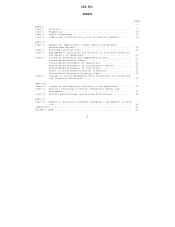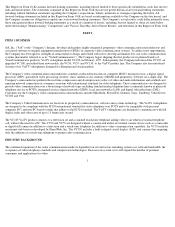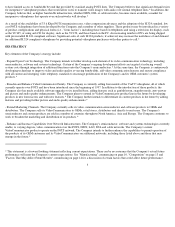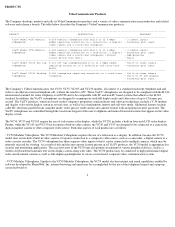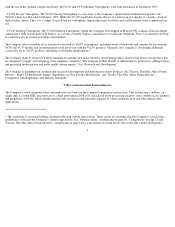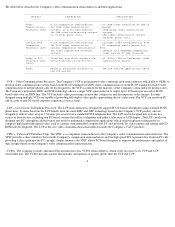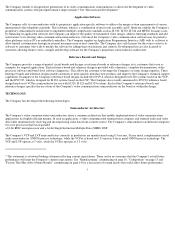8x8 1998 Annual Report Download - page 13
Download and view the complete annual report
Please find page 13 of the 1998 8x8 annual report below. You can navigate through the pages in the report by either clicking on the pages listed below, or by using the keyword search tool below to find specific information within the annual report.Algorithm Expertise
The Company has devoted significant resources to develop video and audio codec algorithms to meet international video telephony standards.
While the H.32x standards clearly specify the syntax requirements of a standards-compliant decoder, and thus what constitutes a valid H.32x
bitstream, they do not specify the methods by which an H.32x encoder generates such a bitstream. The flexibility of the Company's video
communication semiconductor architecture allows the Company to apply its core algorithm expertise to develop products for a variety of video
communication applications.
The Company's algorithm expertise enables the following:
- Video Coding Efficiency and Video Quality. The Company's proprietary motion search, mode decision and rate buffer control algorithms
enhance video quality for H.32x video communication applications.
- Integrated Control of Real-Time Systems. Video communication systems are inherently complex due to the convergence of video, audio and
control information. The Company's proprietary semiconductor architecture and interrupt-driven control software manage these varying data
streams in concert thereby reducing the complexity of the external system design. In addition, the Company's single-chip control of audio and
video data in certain applications provides for audio/video synchronization and low end-to-end latency.
- Robustness to Varying Network Conditions. Video communication systems must interface to networks with transmission characteristics that
vary over time. These characteristics can cause network bandwidth to change and can result in the loss or corruption of transmitted information.
The Company has developed control algorithms that adapt to changes in network bandwidth and that recover from the loss or corruption of
data in a way that reduces negative perceptual effects on the user.
System Design
The Company has developed expertise in integrating its semiconductors and software with peripheral components to produce complete video
communication systems. The Company's system technology consists of modular subsystems that can be rearranged to interface to various
networks (such as POTS, ISDN and LAN) and to interface to various video capture and display devices.
CUSTOMERS AND MARKETING
The Company markets its semiconductors and associated software through its own direct sales force as well as through distributors. The
Company sells its VCP semiconductors and related software and reference designs primarily to OEMs of ISDN office video communication
systems that use the H.320 standard, including PictureTel, Siemens, Sony, VideoServer, VCON and Vtel. The Company sells its LVP
semiconductors and related software and reference board designs to OEMs of POTS video communication systems for the consumer market
using the H.324 standard, such as Kyushu Matsushita Electric Co., Ltd. (KME), Leadtek, Sony and Truedox.
The Company markets its VideoCommunicators through retail channels such as Best Buy, CompUSA, Fry's Electronics, J & R Computer
World, OfficeMax and Staples; catalogs such as Hammacher Schlemmer and MicroWarehouse; and distributors such as D&H, IngramMicro
and Wynit. The Company also sells its VideoCommunicators through a direct marketing effort utilizing a combination of advertising and toll-
free telemarketing in the United States and the United Kingdom. In conjunction with the Company's distributors and resellers, the ViaTV
products are sold in a number of countries throughout North America, Europe and Asia. The Company's VideoCommunicators sales efforts are
supported by co-marketing relationships with third parties such as EFA Corporation, GTE and AT&T.
The Company's direct sales force supports domestic and international sales and operates from the Company's headquarters in Santa Clara,
California and a European office in London. As of March 31, 1998, the Company employed 35 persons in sales and marketing. These persons
provide account support for direct,
9



